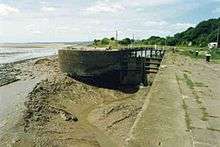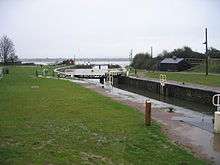Lydney Canal
Lydney Canal | |||||||||||||||||||||||||||||||||||||||||||||||||||||||||||||||
|---|---|---|---|---|---|---|---|---|---|---|---|---|---|---|---|---|---|---|---|---|---|---|---|---|---|---|---|---|---|---|---|---|---|---|---|---|---|---|---|---|---|---|---|---|---|---|---|---|---|---|---|---|---|---|---|---|---|---|---|---|---|---|---|
Legend
| |||||||||||||||||||||||||||||||||||||||||||||||||||||||||||||||




This one-mile canal in Gloucestershire runs inland from the River Severn to Lydney. It was opened in 1813 to trans-ship iron and coal from the Forest of Dean. It was once connected by a horse drawn tramroad to Pidcock's Canal [1] which brought materials down to the wharves by tub-boat.
In the 1960s imported wood was still being brought in by barge from Avonmouth.[2] It remained in commercial use until the 1980s. The entrance to the canal consists of an outer tidal gate opening into a wide basin. From there a lock opens into the one-mile canal cut. Immediately above the lock, a pair of gates point the other way as protection against a high tidal flood in the estuary. There is one swing bridge crossing the canal.
The docks have recently been restored to create a marina and harbour area for seagoing yachts and motor boats.[3]
Timeline
1809 The Lydney and Lydbrook Railway Act enabled construction of a tramroad from Lydbrook to Lydney.[4]
1810 A second Act changed the company name to the "The Severn & Wye Railway and Canal Company" and (amongst other things) authorises the building of the canal to the River Severn at Nass Point.[5]
1810 Josias Jessop (son of William Jessop) was appointed consulting engineer and designed plans for the canal.
1811 Thomas Sheasby (son of Thomas Sheasby senior) was taken on as resident engineer.
1813 The canal was opened by the Severn and Wye Railway and Canal Company.
1821 The outer harbour was finally completed and the tramway extended all the way down.[6]
1825 The north pier was extended to aid ships into the harbour.
1868 The tramway was converted to broad gauge.
1872 Converted to standard gauge.
1893 Severn and Wye Railway and Canal Company went bankrupt.
1894 Purchased by the Great Western and Midland Railways and administered by a Joint Committee of the two companies.[7]
1948 The railway and docks passed to the Western Region of the Railway Executive on nationalization.
1950 Transferred to the Docks and Inland Waterways Executive.
1960 The last coal was shipped from the harbour.[8]
1977 The harbour was closed.
1985 The section from the swing bridge to the Severn was scheduled as an Ancient Monument [9]
1988 The swing bridge was scheduled as a Grade II listed building.[10]
1996 The Environment Agency took over management of the docks.
1997 Inner gates collapses and had to be replaced by a dam to reduce flood risk.
1998 The Lydney Docks Partnership was established to create a sustainable future for the canal.
2005 Re-opened after a two-year project of restoration and enhancement.[11]
The River Lyd

The Lyd is a small river in the Forest of Dean in Gloucestershire, England.
The Lyd flows into the River Severn via the canal in Lydney.
See also
References
- ↑ Lydney Harbour brochure
- ↑ Photo in Francis Frith Collection
- ↑ Lydney Area in Partnership website
- ↑ Forest of Dean Railways
- ↑ Joseph Priestley (1831). Historical Account of the Navigable Rivers, Canals, and Railways of Great Britain.
- ↑ http://www.asiantaeth-yr-amgylchedd.cymru.gov.uk/regions/midlands/567079/567090/893833/894284/464376/458415/?version=1&lang=_e
- ↑ "Lydney Docks". Gloucestershire County Council.
- ↑ http://www.lydney.org.uk/project_lydney_docks.shtml
- ↑ http://www.english-heritage.org.uk/server/show/ConBar.6912
- ↑ http://www.lydney.org.uk/publications/Harbour_brochure.pdf
- ↑ http://www.environment-agency.gov.uk/regions/midlands/567079/567090/893833/894284/464376/665775/
External links
- Photos of Lydney, Francis Frith Collection
- Satellite image from Google Maps
- Photo of the upper basin at Lydney Harbour taken in the 19th century
- Lydney harbour canal full of empty log barges in the 1960s.
- Historical Account of the Navigable Rivers, Canals, and Railways, Joseph Priestley
- Historic England. "Grade II Swing-bridge and abutments. (354463)". Images of England.